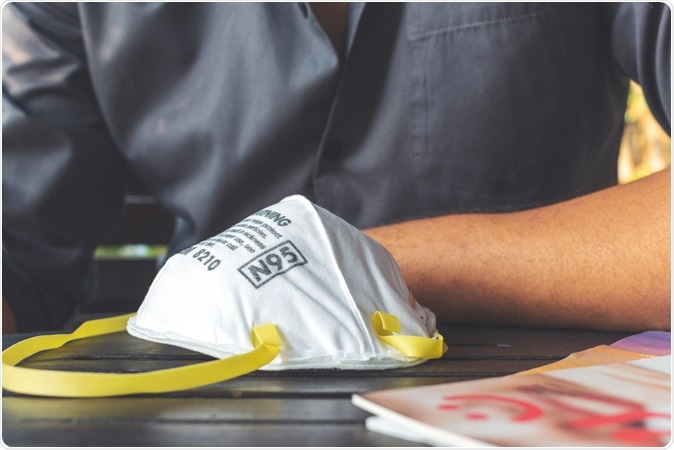The world is gripped by the COVID-19 pandemic caused by the severe acute respiratory syndrome coronavirus 2 (SARS-CoV-2). The health care personnel and those caring for these patients are at considerable risk of contracting the infection. N95 masks have been mentioned as protective face gear to cover the face, nose, and mouth of the user to prevent the spread of the infection via aerosols generated while coughing, sneezing, or even breathing. Due to a large number of infected persons, there has been an acute shortage of these masks necessitating their reuse. Healthcare workers are especially in need of masks, and because of an acute shortage, they are resorting to reusing these masks. There have been several anecdotal reports on the best and most effective way of disinfecting N95 masks.
Researchers from the Department of Materials Science and Engineering, Stanford University, Stanford, and Stanford Institute for Materials and Energy Sciences, SLAC National Accelerator Laboratory, Menlo Park, California, United States, worked on their study titled, “Can N95 Respirators Be Reused after Disinfection? How Many Times?” published in the latest issue of the ACS Nano.

Study: Can N95 Respirators Be Reused after Disinfection? How Many Times? Image Credit: Memory Stockphoto / Shutterstock
What was this study about?
The team writes that there is a significant shortage of the N95 respirators, and the purpose of their study was to “determine how we can reuse respirators and other personal protective equipment in these urgent times.” They explained that these N95 masks contain a fiber layer called “melt-blown polypropylene fibers.” These form a breathable fabric through which the wearer can breathe. These fibers, they write are electrostatically charged in order to filter out and protect the wearer from the smaller particles such as viruses.
Recommendations for use and disinfection
The U.S. Centers for Disease Control and Prevention (CDC) recommends that for the prevention of inhalation and exposure to viral aerosols during the COVID-19 pandemic, the “N95 filtering facepiece respirators (FFR)” should be part of the Personal Protective Equipment (PPE) of the healthcare personnel. This grade, the authors explained, is determined by the CDC’s National Institute of Occupational Safety and Health (NIOSH) (document 42 CFR Part 84). This mask, they wrote, has a minimum filtration capacity of 95 percent for “0.3 μm (aerodynamic mass mean diameter) of sodium chloride aerosols”. There are N99 and N100 standards that allow for a filtration capacity of 99% and 99.97%, respectively, they wrote.
Due to the shortage, healthcare personnel are forced to reuse these masks. According to the CDC, several methods could be used to disinfect these masks. Some of these are;
- Protein denaturation by alcohols or heating
- Disruption of the genetic material – DNA or RNA using Ultraviolet (UV) radiation, peroxides or oxidizers
- Disruption of the cell body using phenolics, chlorides, and aldehydes
What was done?
Yi Cui and colleagues in this study compared these five methods that could be used for disinfection and reuse of the N95 masks. They wanted to see if, after repeated disinfection using one of these methods, the fabric of the masks held up and was equally effective as before. After subjecting a piece of the fabric to the disinfection method, they examined if it was capable of filtering the aerosol particles that appeared as respiratory droplets but lacked the novel coronavirus. They compared the ability of the fabric to filter out the aerosols before and after the disinfection.
Heating as a disinfection method
Results showed that heating at 70 °C for up to 5 minutes was one of the most effective ways as well as user-friendly methods of disinfection. The team wrote that if the melt-blown fabrics and the N95 masks were heated for less than or equal to 85 °C at less than 100 percent relative humidity, it was very effective. They wrote that this method was “the most promising, nondestructive method for the preservation of filtration properties.” They noted that 50 cycles of such heat treatment did not affect the filtration ability of the masks significantly.
They then lowered the humidity to 30 percent relative humidity and found that at 100 °C the filtration ability remained unchanged even after 20 cycles.
Ultraviolet (UV) irradiation as a disinfection method
An alternative to heating is Ultraviolet (UV) irradiation, the team of researchers found. The masks and the fabrics could withstand up to 10 cycles of such irradiation. After around 20 cycles, there was “small degradation” of the fabric, they noted. The sealing and the material strength of the masks could be affected by UV radiation they noted. The dose of UV radiation that could effectively disinfect the masks was, however, not clear, they found.
Other methods
The use of steam, household bleach, and aerosols may lead to degradation of the filtration capacity of the masks and thus leave the “user vulnerable to the viral aerosols,” wrote the researchers. If alcohol or chlorine bleach solution was sprayed on the masks, the filtration capacity fell from 96 percent to 56 percent (for alcohol spray) and 73 percent (for bleach spray), the team wrote.
Conclusions and implications
The team concluded that it is necessary to find ways to safely disinfect and reuse the N95 respirators due to the acute shortage. They warn that their study did not test the ability of the disinfected masks to filter out the coronavirus, but results revealed that heating remained one of the best methods of disinfection of these masks. They also advise against “alcohol solutions, chlorine-based solutions, or soaps to clean the respirator” as these would alter the electrostatic charge within the fabric that helps in the filtration of the viral aerosols.
Journal reference:
Lei Liao, Wang Xiao, Mervin Zhao, Xuanze Yu, Haotian Wang, Qiqi Wang, Steven Chu, and Yi Cui ACS Nano Article ASAP DOI: 10.1021/acsnano.0c03597, https://pubs.acs.org/doi/abs/10.1021/acsnano.0c03597